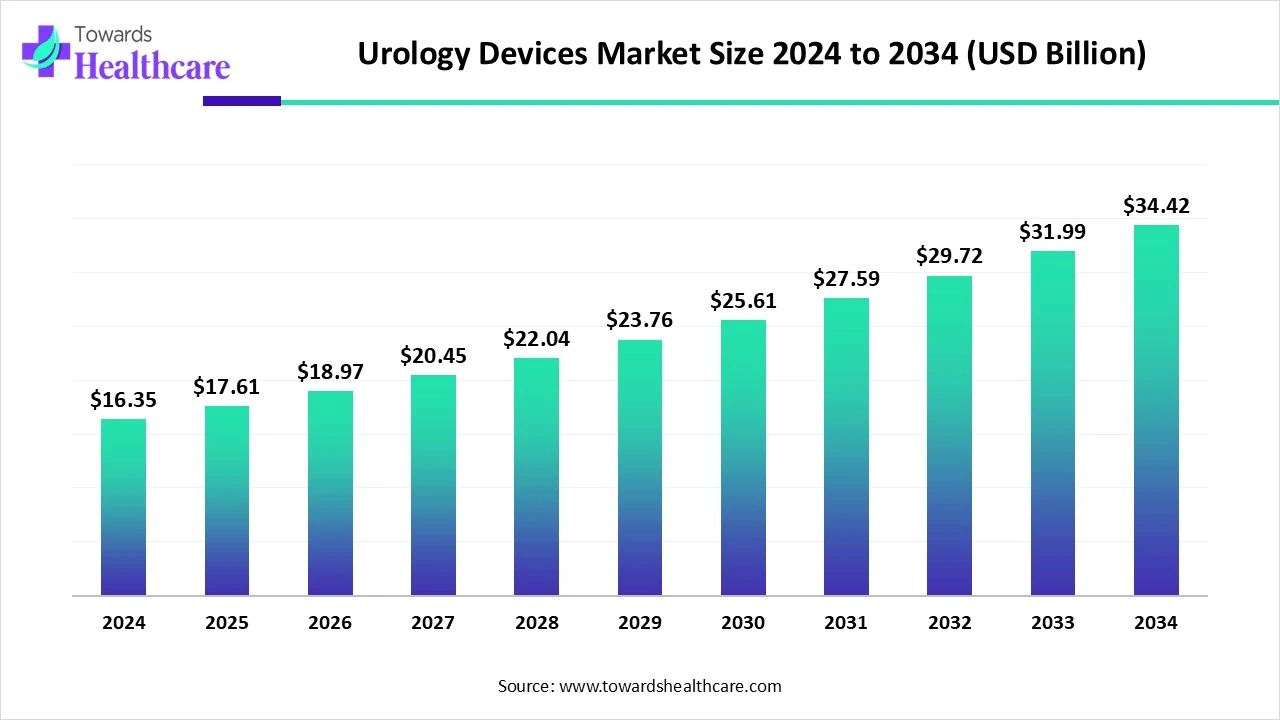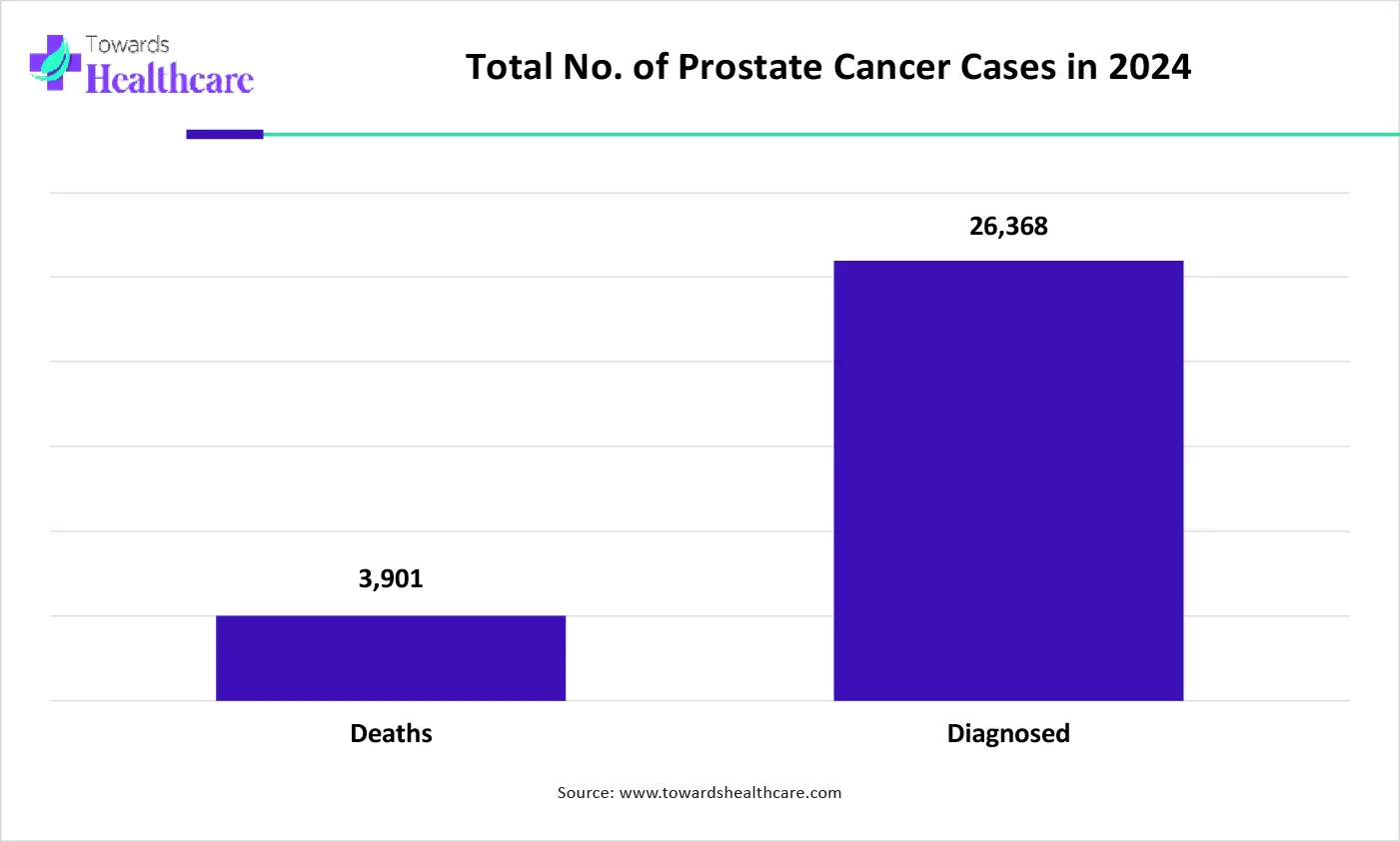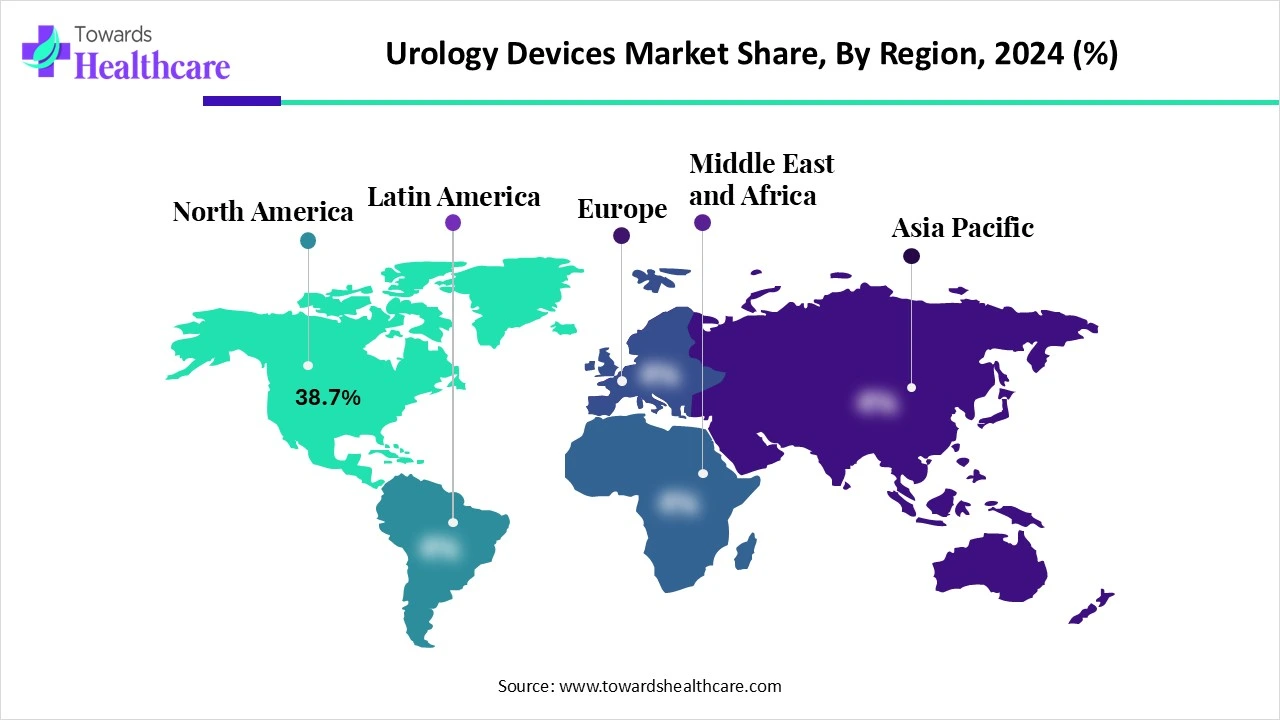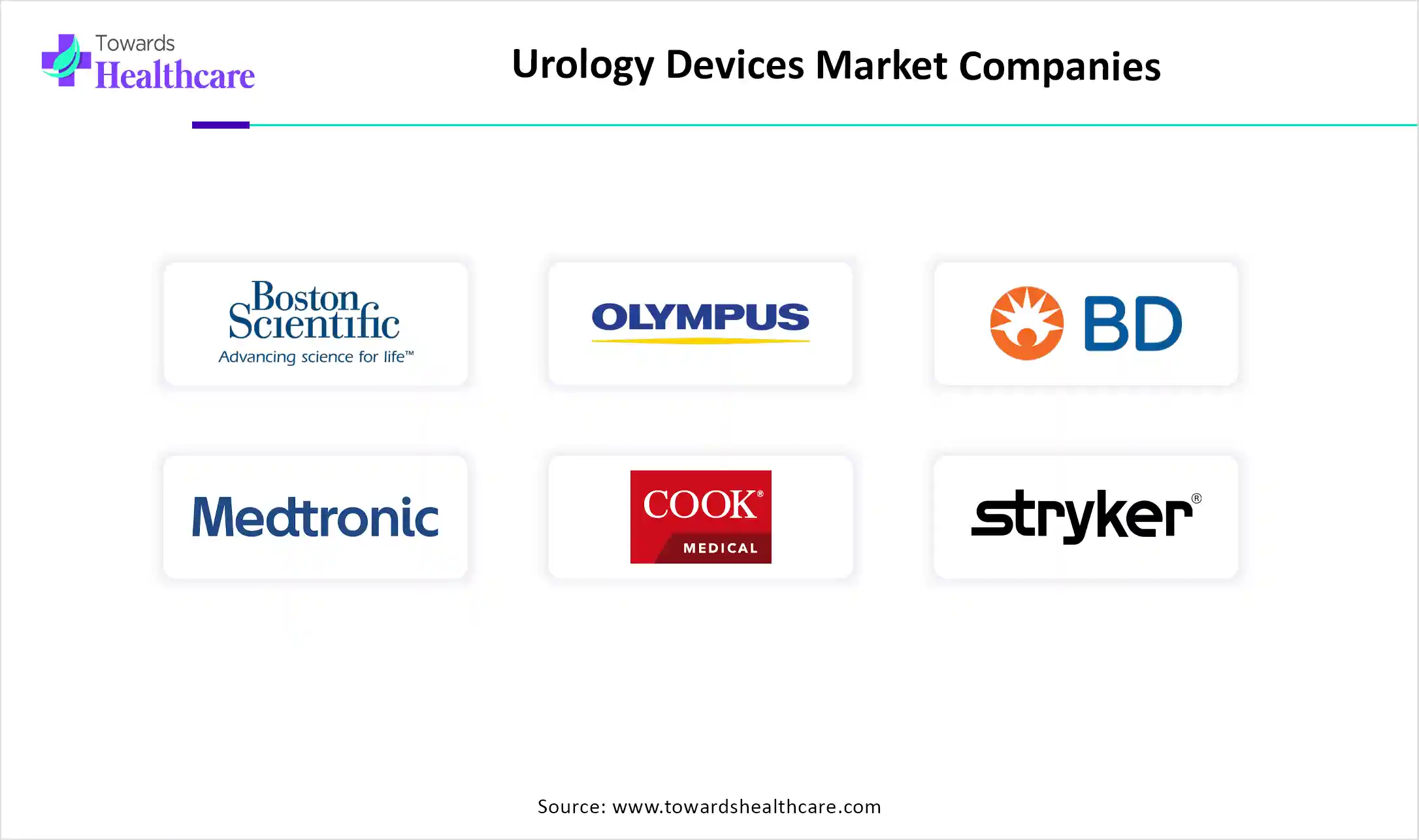October 2025

The global urology devices market size is calculated at US$ 16.35 billion in 2024, grew to US$ 17.61 billion in 2025, and is projected to reach around US$ 34.42 billion by 2034. The market is expanding at a CAGR of 7.74% between 2025 and 2034.

The demand for urology devices is increasing as they are offering effective diagnostic, treatment, and monitoring options that are non-invasive and less painful. Due to growing initiatives for the early detection of urological disorders, their use is increasing. This, in turn, is leading to new developments and collaboration among the companies. Innovation by integrating AI is also being conducted to enhance their applications. Thus, the advancing healthcare infrastructure, expanding healthcare, and growing innovations are enhancing their use in different regions. Hence, this promotes the market growth.
| Metric | Details |
| Market Size in 2025 | USD 17.61 Billion |
| Projected Market Size in 2034 | USD 34.42 Billion |
| CAGR (2025 - 2034) | 7.74% |
| Leading Region | North America share by 38.7% |
| Market Segmentation | By Product Type, By Application, By End User, By Technology, By Region |
| Top Key Players | Boston Scientific Corporation, Olympus Corporation, Becton, Dickinson and Company (BD), Medtronic plc, Cook Medical Inc., Stryker Corporation, Richard Wolf GmbH, KARL STORZ SE & Co. KG, Coloplast Group, Teleflex Incorporated, Dornier MedTech, Siemens Healthineers, Intuitive Surgical, Inc., Fresenius Medical Care AG & Co. KGaA, Nikkiso Co., Ltd., Nipro Corporation, Asahi Kasei Corporation, B. Braun Melsungen AG, AngioDynamics, Inc., Quanta Dialysis Technologies |
The urology devices market encompasses the production, distribution, and use of medical devices intended for the diagnosis, treatment, and management of conditions affecting the urinary tract system and male reproductive organs. These devices are used across a range of urological procedures such as kidney stone removal, prostate and bladder surgeries, erectile dysfunction management, urinary incontinence treatment, and diagnostic imaging. The market includes instruments and equipment such as endoscopes, lasers, dialysis devices, urodynamic systems, catheters, and consumables designed for both minimally invasive and conventional procedures across hospitals, clinics, and ambulatory care settings.
The use of AI to enhance the performance of urology diagnostic and treatment devices is increasing. It can accurately interpret and detect any urological condition. By using the genetic information of the patient, the disease progression can be predicted, and personalized treatment plans are also provided. It is also being used in robot-assisted surgical systems to enhance their control and precision. It, in turn, helps in minimizing the errors. Furthermore, it is also being used to develop wearable monitoring systems.
Growing Incidences of Urological Disorders
The urological disorders in the aging population, patients with chronic diseases, as well as a sedentary lifestyle, are increasing. This, in turn, is increasing the demand for diagnostic, treatment, as well as monitoring devices. Therefore, for accurate diagnosis, the use of endoscopy, biopsy tools, and non-invasive imaging devices is increasing. Similarly, the use of catheters, stents, and robotic-assisted surgical systems is also increasing. Furthermore, new monitoring devices are also being developed. Thus, all these developments are driving the urology devices market growth.
Limited Access
The cost associated with a urology device is high. This affects their utilization by the hospitals with a lack of infrastructure. At the same time, for their proper handling, expertise is required. Thus, this limits access to urology devices for the hospitals as well as the patients, reducing their use.
Increasing Innovations
Various innovations are being developed in the industries as well as institutes to deliver accurate and effective diagnostic and treatment devices. These innovations are particularly focusing on the development of less painful and non-invasive devices, unlike the traditional methods. Hence, next-generation robotic systems with enhanced precision and 3D visualization are being developed. For targeted prostate biopsies, new systems like the fusion biopsy system and multiparametric MRI are also being developed. Furthermore, laser technologies, smart catheters, etc, are also being developed. All these innovations are promoting the urology devices market growth.
For instance,
By product type, the urology endoscopes segment led the market with a 16.2% share in 2024. The urology endoscopes were mostly used for the diagnosis of kidney stones and bladder tumors. Moreover, its minimally invasive method enhanced its use. This contributed to the market growth.
In the urology endoscopes segment, the flexible ureteroscopes sub-segment dominated the market. They were used for the detection of complex urological disorders. Moreover, due to its flexible and enhanced imaging, safe surgical procedures were conducted, which improved the patient outcomes.
By product type, the urology robotic systems segment is expected to show the highest growth at a notable CAGR during the predicted time. These systems provided accurate results, which increased their use in complex treatment approaches. Their minimally invasive approaches are increasing their acceptance rate.
In the urology robotic systems segment, the robotic instruments & accessories sub-segment is the fastest growing. Their use is increasing due to their frequent replacement and repeated use. Furthermore, they are essential for robotic systems, which in turn enhances their demand.
By application type, the kidney diseases segment held a dominating share of 22.4% in the market in 2024. The demand for urology devices increased as there was a rise in kidney disease. Moreover, due to its relapses, the use of ureteroscopes, stents, etc, increased. Additionally, the growing awareness led to increased use of diagnostic devices.
By application type, the urological cancer segment is expected to show the fastest growth rate during the predicted time. The growing urological cancer burden is increasing the use of urology devices. This, in turn, is also driving the use of AI-based devices for its early and accurate diagnosis.

The graph represents the total number of patients with prostate cancer observed in Australia in the year of 2024. It indicates that there will be a rise in new cases of prostate cancer. Hence, it increases the demand for new urology devices for its effective management. Thus, this in turn will ultimately promote the market growth.
By end user, the hospitals segment led the global market with a 41.3% share in 2024. Hospitals utilize different types of urology devices for conducting the diagnosis and treatment of various urological disorders. At the same time, the reimbursement policies increased their use, which improved the patient outcome. This enhanced the market growth.
By end user, the ambulatory surgical centers (ASCs) segment is expected to show the highest growth during the upcoming years. These centers are providing various advanced urology devices at affordable prices. Moreover, the personalized care and insurance policies are attracting patients.
By technology type, the minimally invasive surgery devices segment held the largest share of 28.6% in the market in 2024. These devices were the preferred option as they offered less scarring, pain, and a faster recovery. It also minimized the risk of infections and was thus used in various surgical procedures. This promoted the market growth.
By technology type, the robotic-assisted devices segment is expected to show the fastest growth rate during the upcoming years. Their use in complex surgeries is increasing due to their enhanced precision and accuracy. This is driving their use in the treatment of urological cancers. Furthermore, growing innovations are also enhancing their use.

North America dominated the urology devices market share by 38.7% in 2024. The healthcare sector in North America consisted of well-established infrastructure with advanced technologies. This enhanced the use and the development of urology devices. Thus, this contributed to the market growth.
The demand for urology devices in the U.S. is increasing due to growing incidences of urological diseases. Thus, the presence of well-developed healthcare is playing a significant role by providing advanced devices and reimbursement policies. This, in turn, is promoting their use and adoption.
For early detection and effective treatment of urological disorders, new devices and platforms are being developed. At the same time, new collaboration among the industries are enhancing their research and development. These are further supported by the investments from various sources.
Asia Pacific is expected to host the fastest-growing urology devices market during the forecast period. The healthcare sector in the Asia Pacific is experiencing an expansion with growing investments, along with the adoption of advanced technologies. The growing risk of urinary disorders is increasing the use of urology devices. This enhances the market growth.
The growing incidence of urological disorders is increasing the demand for effective and accurate diagnostic, treatment, and monitoring devices. The growing awareness also contributes to the same. Moreover, the growing utilization of advanced technologies is enhancing the affordability and access, which is improving the treatment approaches.
The expanding healthcare is increasing the adoption of urology devices. At the same time, growing research and development are driving new innovations. Furthermore, the growing medical tourism is increasing the use of urology devices to provide affordable and effective treatment services, which is improving patient outcomes.
Europe is expected to grow significantly in the urology devices market during the forecast period. Due to increasing programs, campaigns, and digital platforms, the awareness about urological disorders among the citizens of Europe is increasing. This is increasing the research and development, along with the growing demand for urology devices. This is promoting the market growth.
The growing chronic diseases are increasing the risk of urological disorders in the aging population of Germany, increasing the use of urology devices. At the same time, various screening programs for its early detection are also being conducted by the government. This is increasing the use of various diagnostic and treatment devices.
The industries as well as the institutions in the UK are developing new approaches to tackle the growing urological disorders. This is leading to the development of new minimally invasive and robot-assisted surgical devices. These developments are further supported by the regulatory bodies.

By Product Type
By Application
By End User
By Technology
By Region
October 2025
October 2025
September 2025
September 2025